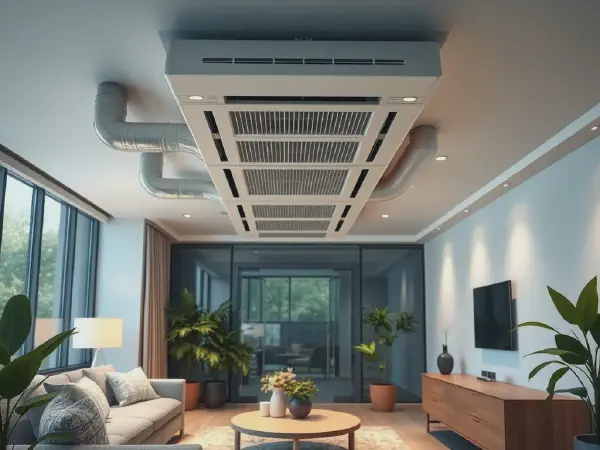Ultimate Guide to Ducted Air Conditioning Systems

Ducted Air Conditioning: A Comprehensive Guide
Ducted air conditioning is a popular climate control solution designed for whole-home comfort. This system uses a network of ducts installed within walls and ceilings, allowing cool or warm air to flow evenly throughout all rooms. It is especially favored for its unobtrusive design and ability to maintain a consistent temperature across large spaces, unlike traditional cooling methods that may leave certain areas too hot or too cold.
There are numerous advantages to choosing ducted air conditioning for your home or commercial space. It offers a centralized system that requires minimal maintenance and provides a quiet operation, ensuring a peaceful indoor environment. With ducted systems, homeowners can also benefit from zoning capabilities, enabling them to control the temperature in different areas, thereby increasing energy efficiency and comfort.
In Melbourne's variable weather, investing in ducted heating and cooling melbourne offers a seamless solution for year-round comfort.
The key components of ducted air conditioning include an outdoor unit—responsible for exchanging heat—and an indoor unit that distributes air through ducts. The air is cooled or heated using refrigerant, which circulates within the system. This technology allows for superior climate control, making ducted air conditioning an ideal solution for both residential and commercial spaces.
When considering ducted air conditioning, it's essential to understand the varying types of systems available and their unique benefits, particularly when it comes to energy efficiency, cost savings, and improved comfort. A comprehensive knowledge of these systems helps homeowners make informed decisions, ensuring their needs are met effectively.
In summary, ducted air conditioning presents a sophisticated and effective alternative to conventional air conditioning systems, providing not only superior comfort but also enhancing the aesthetic appeal of your living or working space. This article explores the various aspects of ducted air conditioning, from its benefits and different types to installation, maintenance, and troubleshooting techniques.
Benefits of Ducted Air Conditioning
One of the primary benefits of ducted air conditioning is its energy efficiency. Designed to distribute air consistently, ducted systems utilize advanced technology to reduce energy consumption, making them more environmentally friendly. Many models come with programmable thermostats, allowing users to optimize usage based on occupancy, further enhancing energy savings.
Cost savings are another significant advantage of ducted air conditioning systems. Although the initial installation costs may be higher than traditional split systems, the long-term savings on energy bills and maintenance can offset this investment. Additionally, ducted systems tend to last longer due to their robust design, providing a worthwhile return on investment.
Ducted air conditioning improves indoor air quality significantly. With proper filtration systems in place, these units can eliminate dust, allergens, and other pollutants, providing fresher air. Additionally, effective temperature control allows for better humidity management, creating a more comfortable living environment.
For optimal climate control, consider installing air conditioners split system units that efficiently cool your home all summer long.
The aesthetic advantages of ducted air conditioning cannot be overlooked. The installation of ducted systems is discreet, with vents and grills designed to blend seamlessly with interiors. This design enhances the visual appeal of homes or offices by eliminating bulky units, allowing for a cleaner and more modern look.
Types of Ducted Air Conditioning Systems
Reverse cycle ducted systems are among the most versatile options available. They can both heat and cool indoor spaces, making them suitable for year-round comfort. With the added benefit of energy efficiency, reverse cycle systems are a popular choice for homeowners looking to optimize their climate control.
Evaporative ducted cooling systems are ideal for dry climates, utilizing water to cool air naturally. This system circulates cool, moist air throughout the home, resulting in a refreshing indoor environment. They are also energy efficient and can significantly reduce electricity costs in suitable conditions.
Multi-head ducted air conditioners are perfect for homes without centralized ductwork. These systems feature multiple indoor units connected to a single outdoor unit, allowing for individualized temperature control in different rooms without extensive modifications to the building structure.
Smart ducted air conditioning systems take convenience to the next level. Equipped with smart technology, these systems can be controlled remotely via smartphone apps, allowing users to adjust temperatures, monitor energy consumption, and receive alerts about system performance, enhancing user control and efficiency.
Installation of Ducted Air Conditioning
The installation of ducted air conditioning typically involves several steps: assessing the property's layout, sizing the system correctly, installing ducts and vents, placing indoor and outdoor units, and connecting electrical and refrigerant lines. Proper installation is crucial for efficient operation and long-term performance.
Tools required for installation include a drill, ducting equipment, metal shears, tape, and insulation materials. Additionally, safety gear such as gloves and goggles, as well as access to ladders for high install areas, are essential for ensuring a smooth installation process.
Common challenges during installation include ensuring optimal duct placement to avoid hot and cold spots, managing structural obstacles within the walls and ceilings, and adhering to local regulations and building codes. Experience and careful planning can help mitigate these issues.
Deciding between professional installation and DIY options depends on the complexity of the system and the homeowner's skill level. While professional installation guarantees a correctly fitted and efficient system, DIY installation can save costs but may result in difficulties if not executed correctly. It's crucial to evaluate capabilities before proceeding with either option.
Maintenance of Ducted Air Conditioning
Regular servicing tips for ducted air conditioning include scheduling annual professional maintenance checks, cleaning or replacing filters every three months, and keeping outdoor units clear of debris. These practices help extend the system's lifespan and maintain efficiency.
Cleaning ductwork is vital for maintaining air quality and efficient airflow. Periodically, it's recommended to hire professionals to clean the ductwork, as built-up dust and allergens can accumulate and hinder performance, leading to potential health issues.
Signs your system needs maintenance include inconsistent cooling or heating, unusual noises, increased energy bills, and unpleasant odors from the vents. Addressing these issues promptly can prevent more severe problems and costly repairs in the long run.
DIY maintenance tasks, such as changing filters and cleaning vents, can help homeowners save on maintenance costs. However, more complex tasks, such as checking refrigerant levels and inspecting electrical components, should be left to professionals to ensure safety and operational efficiency.
Troubleshooting Ducted Air Conditioning Issues
Common issues with ducted air conditioning include insufficient airflow, strange noises, and fluctuating temperatures. Fixes may involve cleaning or replacing the air filter, checking for duct leaks, or ensuring that the thermostat is functioning correctly—addressing these early can save on repair costs.
Many modern systems come with diagnostic tools that allow users to read error codes displayed on the thermostat. These codes can indicate specific malfunctions that guide troubleshooting. It's important to consult the user manual to understand what each code signifies.
Knowing when to call a technician is crucial, especially for complex issues that involve refrigerant leaks or electrical components. If simple troubleshooting doesn’t resolve the problem, it's advisable to contact a qualified technician to prevent further damage to the system.
Preventive measures for system failures include regular maintenance, checking for signs of damage or wear, and monitoring the system for unusual noises or behaviors. Adopting good practices can prolong the lifespan of ducted air conditioning systems and optimize their efficiency.
Comparing Ducted vs Split Systems
Cost comparison between ducted and split systems often shows that while ducted air conditioning requires a higher initial investment, the long-term savings in energy bills and maintenance can make it a more economical choice for larger homes or commercial spaces.
Energy efficiency analysis reveals that ducted systems often perform better in larger areas due to their ability to maintain consistent temperatures. Split systems may work well in smaller spaces, but energy consumption may increase if multiple units are required to cool or heat a whole house.
Space and design considerations play a pivotal role in choosing between ducted and split systems. Ducted systems are less intrusive and can be hidden within the structure, while split systems require visible indoor units on walls. This aspect significantly impacts the overall aesthetic of a home or office.
Ultimately, the choice between ducted and split systems depends on individual needs, the size of the property, and budget considerations. Ducted systems are ideal for those seeking whole-home climate control, whereas split systems may be suitable for smaller, separate areas with unique cooling/heating demands.
